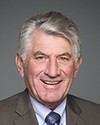Mr. Speaker, as of June 3, 2022, the in-force Order in Council, or OIC, regarding COVID-19 is OIC 2022-0567, “Minimizing the Risk of Exposure to COVID-19 in Canada Order”. OIC 2022-0567 came into force on May 31, 2022. The OIC was repealed and replaced by “OIC 2022-0836 Minimizing the Risk of Exposure to COVID-19 in Canada Order” on June 27 and remains in effect until September 30, 2022.
With regard to (a), the Government of Canada’s decision with respect to COVID19 border measures continue to be based on epidemiological scientific evidence.
The government’s top priority is the health and safety of Canadians. To limit the introduction and spread of COVID-19 in Canada, the government has taken unprecedented action to implement a comprehensive strategy with layers of precautionary measures.
SARS-CoV-2 was first detected in Wuhan, China, in December 2019, and was a new strain of virus that had never before been seen in humans. SARS-CoV-2 causes the disease COVID-19. Canada’s first case of the disease was confirmed on January 27, 2020. Originally seen to be a local outbreak, COVID-19 spread rapidly, and on March 11, 2020, the World Health Organization, WHO, declared a COVI-19 pandemic. Five days later, Canada had 401 confirmed cases, and the chief public health officer, or CPHO, of Canada stated that COVID‑19 posed a serious health risk. COVID-19 has now affected the majority of countries around the world. As of June 13, 2022, over two years after the WHO declared a pandemic, the WHO COVID-19 dashboard was reporting more than 533 million global cases and more than 6.3 million global deaths.
Between February 3, 2020, and May 31, 2022, 79 emergency OICs were made under the Quarantine Act to minimize the risk of exposure to COVID-19 in Canada, to reduce the risk of importation from other countries, to repatriate Canadians and to strengthen measures at the border to reduce the impact of COVID-19 in Canada. Combined, these measures have been effective in significantly reducing the number of travel-related cases.
Any changes to international travel restrictions and advice are based on national and international evidence-based risk assessments. With the COVID-19 vaccines assisting in pandemic control measures, the government has used a phased approach to easing border measures for fully vaccinated travellers and maintaining requirements for unvaccinated travellers. These decisions are grounded in meeting specific public health criteria, and based on scientific evidence and the epidemiological situation in Canada and globally.
With regard to (b), epidemiological scientific evidence underpinned the government’s COVID-19 border measures, including those that remain in place as of June 3, 2022.
As of June 3, 2022 under “OIC 2022-0567 Minimizing the Risk of Exposure to COVID-19 in Canada Order”, foreign nationals intending to enter Canada must meet the specified vaccination requirements. In addition, travellers permitted entry into Canada are subject to requirements for tests, quarantine and other post-border measures, as applicable, in Canada.
With regard to (c), the Government of Canada engages its international partners, and leverages the WHO’s unique convening role to bring together expertise and resources from nearly 200 member states via initiatives such as the technical advisory group on SARS-CoV-2 virus evolution and the WHO hub for pandemic and epidemic intelligence to monitor and evaluate the evolution of COVID-19 and other infectious diseases.
The scientific evidence used to inform Canada’s international border measures was based on the epidemiological situation in Canada, the global body of epidemiological evidence on COVID-19, and the effectiveness of related public health measures and global trends. Canadian measures are implemented in the interest of the health and safety of the Canadian public.
Likewise, Canada’s high vaccination rates and epidemiological situation supported the lifting of pre-arrival testing for fully vaccinated travellers as of April 1, 2022. Pre-arrival testing requirements remain in place for unvaccinated travellers five years of age or older, except for children under the age of 12 if they are accompanying a fully vaccinated adult. To protect against the introduction and spread of COVID-19 and its variants in Canada and to reduce the potential burden on the health care system, the Government of Canada continues to take a precautionary approach by maintaining current quarantine and testing requirements for unvaccinated travellers and limiting entry to fully vaccinated foreign nationals and persons with right of entry into Canada, with limited exceptions.
With regard to (d), the scientific evidence used to inform Canada’s international border measures was based on the epidemiological situation in Canada, the global body of epidemiological evidence on COVID-19, and the effectiveness of related public health measures and global trends. Canadian measures are implemented in the interest of the health and safety of the Canadian public.




















